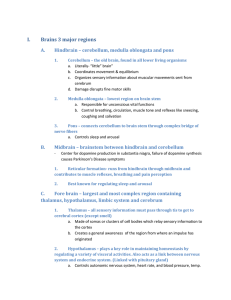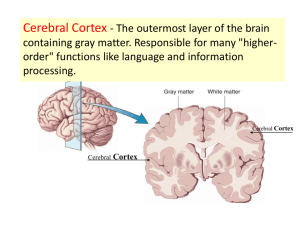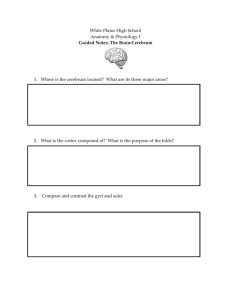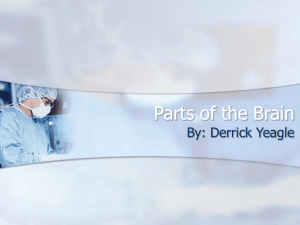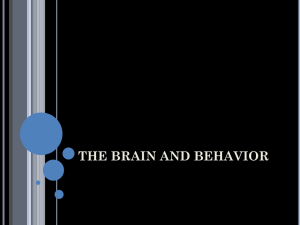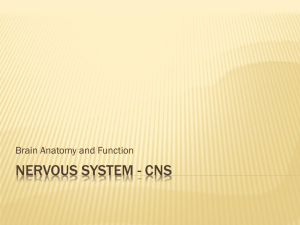Chapter 14: The Brain and Cranial Nerves
advertisement
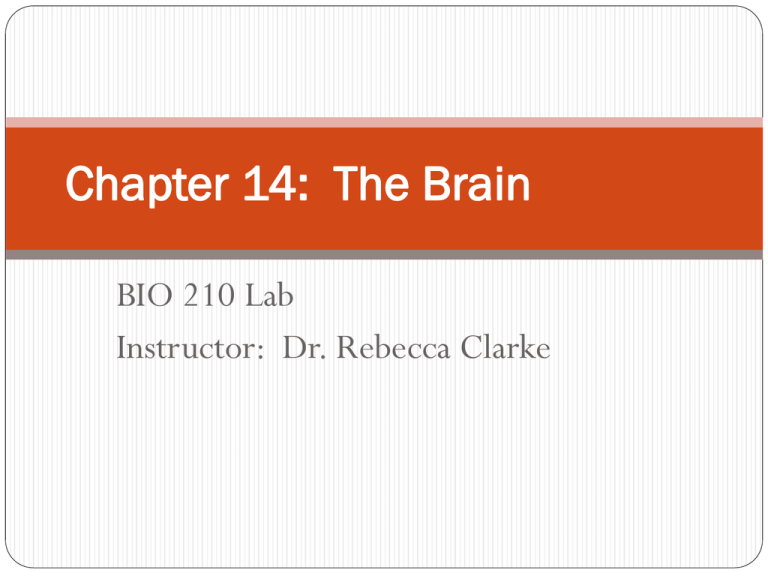
Chapter 14: The Brain BIO 210 Lab Instructor: Dr. Rebecca Clarke Human Brain Contains almost 98% of body’s neural tissue Average weight about 3 lb (1.4 kg) 6 Major Regions of the Brain Cerebrum Cerebellum Diencephalon Mesencephalon Pons Medulla oblongata The Brain Embryological Development Determines organization of brain structures Neural tube Origin of brain Enlarges into three primary brain vesicles prosencephalon mesencephalon rhombencephalon The Brain Five Secondary Brain Vesicles Telencephalon Diencephalon Mesencephalon Metencephalon Myelencephalon The Brain Origins of Brain Structures Diencephalon and mesencephalon persist Telencephalon: Becomes cerebrum Metencephalon Forms cerebellum and pons Myelencephalon Becomes medulla oblongata The Brain Cerebrum Controls higher mental functions Largest part of brain (80% of volume) Cerebrum Divided into large L and R cerebral hemispheres Longitudinal fissure: Separates upper part of R & L hemispheres Corpus callosum: Thick, crescent-shaped band of white matter Connects R & L hemispheres Cerebrum Corpus Callosum Figure 14–11a Cerebral Cortex Surface layer of gray matter on cerebrum Also called neural cortex Folded surface: Increases surface area Provides space for more cortical neurons Cerebral Cortex Folded surface has: Gyri (sing: gyrus) = elevated ridges Sulci (sing: sulcus) = hollow depressions Fissures = deep grooves Cerebrum Sulci and fissures divide cerebral hemispheres into distinct lobes (regions) (named for overlying bones of skull) Cerebral Structures Central sulcus Groove across hemi-sphere Separates motor and sensory areas Postcentral gyrus Upfold posterior to central sulcus Primary sensory cortex Precentral gyrus Upfold anterior to central sulcus Primary motor cortex Cerebral Lobes Frontal lobe Motor cortex Parietal lobe Sensory cortex Occipital lobe Visual cortex Temporal lobe Auditory cortex Olfactory cortex Cerebral Structures: Insula “5th lobe;” deep “island” of cortex medial to lateral sulcus Exposed when temporal lobe pushed to side Site of gustatory cortex Cerebral Gray Matter Found in: Cerebral cortex Cerebral nuclei Cerebral White Matter Myelinated nerve fibers Makes up most of interior of cerebrum Located: Deep to cerebral cortex Around cerebral nuclei Ventricles of the Brain Chambers lined with ependymal cells CSF 4 ventricles: 2 lateral (R & L), 3rd, 4th Ventricles of the Brain: Lateral Ventricles (First 2) 1/cerebral hemisphere Ventricles of the Brain: 3rd Ventricle In diencephalon between R & L thalami Connects to lateral ventricles via interventricular foramen (of Monro) Ventricles of the Brain: 4th Ventricle Extends between pons and cerebellum into medulla oblongata; becomes continuous with central canal of spinal cord Connects to 3rd ventricles via mesencephalic (cerebral) aqueduct CSF Circulation Choroid Plexus Through ventricles To central canal of spinal cord Into subarachnoid space around brain, spinal cord, and cauda equina Enters venous circulation Cranial Meninges Have 3 layers (like spinal meninges): Dura mater Arachnoid mater Pia mater Are continuous with spinal meninges Protect the brain from cranial trauma (act as “air bags”) Cranial Meninges: Dura Mater 2 Fibrous layers Outer (endosteal) layer Fused to periosteum of cranial bones No epidural space (vs. spinal cord) Inner (meningeal) layer In some locations folds into cranial cavity between hemispheres dural folds Venous (dural) sinus between layers Cranial Meninges: Dural Folds Folded inner layer of dura mater Extend into cranial cavity Stabilize and support brain (act like “seat belts”) Contain collecting veins (dural sinuses) [FYI: falx cerebri, tentorium cerebelli, falx cerebelli] Cranial Meninges: Arachnoid Mater Consists of: Arachnoid membrane Epithelial layer Covers brain (does not follow folds) Arachnoid trabeculae Cells and fibers that cross subarachnoid space to pia mater Cranial Meninges: Pia Mater Attached to brain surface by astrocytes Cerebellum Coordinates repetitive body movements Second largest part of brain 10% of volume but 50% of neurons Cerebellum R & L cerebellar hemispheres: Separated at midline by vermis Vermis: Narrow band of cortex Cerebellum Highly folded cerebellar cortex folia (less prominent than gyri) Arbor vitae: central, tree-like branching mass of white matter deep to cortex Diencephalon Located in central region of brain deep to cerebrum Links cerebrum with brain stem Diencephalon 4 Regions: Thalamus – L & R: Masses of gray matter (nuclei) Forms walls of third ventricle Hypothalamus: Below thalamus Forms floor and part of walls of thalamus Diencephalon Third ventricle: Separates L & R thalamus Pineal gland: Secretes hormone melatonin Diencephalon Intermediate mass: Projection of gray matter Extends into ventricle from each side of thalamus Hypothalamus Has neural and endocrine functions Infundibulum Stalk that connects pituitary gland to hypothalamus Pituitary Gland Brain Stem Processes information between: Spinal cord and cerebrum or cerebellum Includes: mesencephalon, pons, medulla oblongata Mesencephalon (Midbrain) 2 pairs of sensory nuclei (corpora quadrigemina): Superior colliculi (visual) Inferior colliculi (auditory) Pons Links cerebellum with mesencephalon, diencephalon, cerebrum, and spinal cord Involved in motor control Medulla Oblongata Connects brain to spinal cord Regulates complex autonomic functions: Heart rate, blood pressure, respiration Continuous with spinal cord
